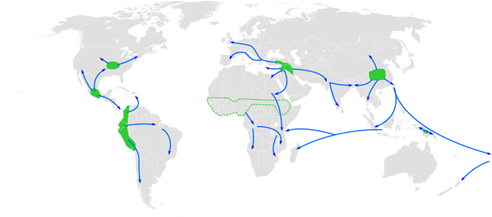Global food security/GFS101/Exploring the Global Food System/Origins and Development of Agriculture
The global food system has become the dominant mechanism for food production and consumption in many parts of the world. To being we take we take a look at agriculture and its origins. While there are many forms of agriculture it is commonly defined as the
The science or practice of farming, including cultivation of the soil for the growing of crops and the rearing of animals to provide food, wool, and other products. Source: Agriculture. (n.d.). In Oxford Living Dictionaries. Retrieved from https://en.oxforddictionaries.com/definition/agriculture
A notable feature of this definition is the use of the conjunction ‘or’ to differentiate between agriculture as a science or practice. This dual construction acknowledges agriculture long history as a practice by different cultures. Aquaculture is the aquatic equivalent of agriculture.
For most of human history, hunting and gathering of wild animal and plant species represented the means of sustenance for a largely nomadic way of life. It was only after the 'Neolithic Revolution' around 10000 years ago that we start to see humans, aided by the practice of agriculture, develop more permanent settlements and specialisations needed for village life.
More recent research acknowledge a type of proto-agriculture used even earlier, for example, aboriginal culture in Australia and many other indigenous cultures across the world have been using 'fire stick farming' to herd animals and distribute different plant communities to make resources more predictable.
While there are differing views on the exact dates for the when agriculture took hold across the globe the following map indicates how it spread out from different centers of human settlement. A notable feature of the early period in the practice of agriculture is the domestication of wild plants and animals. Domestication involved the selective breeding of wild animals and plant into the cultivated forms we see today.
It is important to recognise that agriculture as a practice and science provides predictability in food resources and that through most of its history has varied across time and space and has been shaped by the social, material and environmental context in which it is placed. As a practice, it has been carried through by different knowledges, competences and crafts of cultivation, different technologies, different cultural meanings and traditions associated with it.
In the following lecture, Rich provides a quick historical account of the development of agriculture from its origins, noting its link with population growth and technology. He also briefly discusses the role of mechanisation to agriculture and the rise of industrial agriculture after the industrial revolution. He also touches on how industrial innovations to agriculture have been credited with the so-called 'green revolution' that began around the 1940s, which helped to increase food production in many developing nations.
****REPLACE VIDEO CONTENT - XBR103Week2Video1EDITED*****
After watching the previous lecture have another look at the graph by Mazoyer & Roudart (2006) of key 'stages in the process of motor mechanisation in grain production'. XXXXX where is graph XXXXXXXX After watching the previous lecture brainstorm the following questions:
1. What are some other implications of these graphs?
2. What do they suggest about the future of food production?
Please direct your self to the Discussion Board titled: Activity 3: Why has food production increased? so that other students can engage with your response. Feel free to comment on other posts as it will help you with your own thinking.



